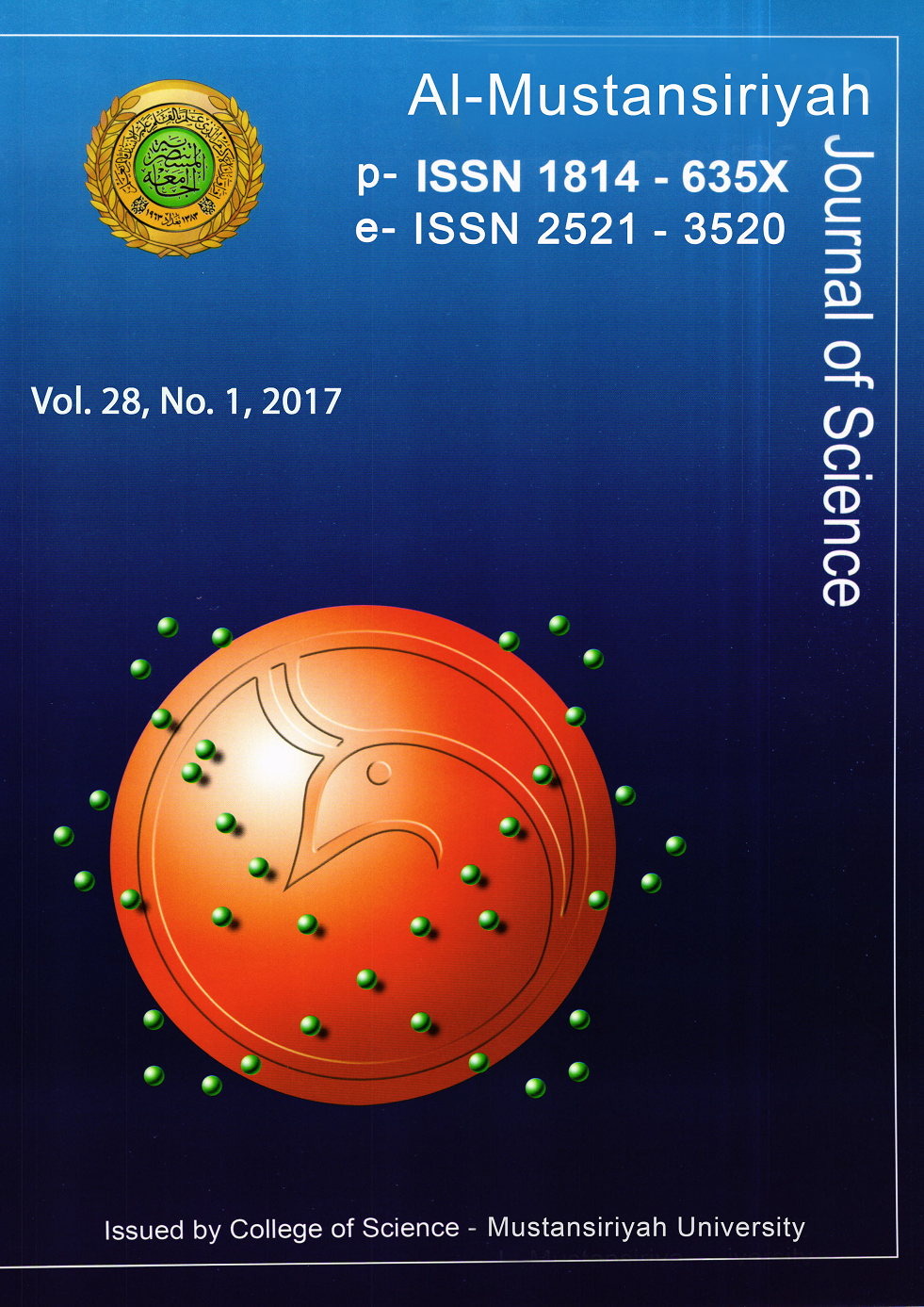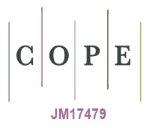Activity of Some Disinfectants, Detergents and Essential Oils on Growth of the yeast Candida albicans
DOI:
https://doi.org/10.23851/mjs.v28i1.308Keywords:
Candida albicans, plant oils, hydrogen peroxide, apple cider vinegar, detol, lugol's iodine, synergism, antagonismAbstract
The study was conducted for estimating antifungal activity against Candida albicans of ten essential oil, garlic and onion juice, eight disinfectants and detergents by using agar diffusion well method. The results showed high activity of clove oil, onion juice 50%, thyme oil, hydrogen peroxide (H2O2), lugol's iodine and detol for all the five concentration, sodium chloride (NaCl) and sodium carbonate (Na2CO3) at 5%, while the effect of apple cider vinegar were at 60% and 80%. Sodium hypochlorite showed moderate activity at all concentration. The result of combination between clove oil and coconut oil led to synergistic effect while the combination between each of (1, 2, 3 % H2O2 with each of apple cider vinegar and NaCl), (sodium chloride with apple cider vinegar) and (pumpkin oil with clove oil) lead to antagonism as well as the same results were reported when apple cider vinegar mixed with each of (thyme oil) and (clove oil with coconut oil). On the other hand, there is no synergistic or antagonistic effect of combination between 4-5% of H2O2 with apple cider vinegar and NaCl solution to the growth of C. albicans. It was concluded that solitary use of compounds (clove oil, onion juice, thyme oil, H2O2, NaCl, lugol's iodine, detol, and apple cider vinegar) was associated with high antifungal response regarding C. albicans; efficacy was reduced when used in combination. In exception to above finding synergistic effect was identified when a combination between clove oil and coconut oil.Downloads
References
Todeschini, G. T. Treatment of candidiasis: a perspective on recent advances and future challenges. Int. J. Infect. Dis. 1: S37-S41. 1997
Wilson, L.S; Reyes, C.; Stolpman, M; Speckman, J; Allen, K. and Beney J. The direct cost and incidence of systemic fungal infections. Value Health 5: 26-34. 2002 CrossRef
Scheinfeld, N. S. and Lambiase, M. C. Candidiasis, Cutaneous, 2010. Online. Updatedoct.
Kauffman, C.A. Fungal infections. Proc Am Thorac Soc. 3, 35–40. 2006 CrossRef
Cutting, K. F. and Butcher, M. Antimicrobial technology: a new paradigm in bioburden management. J Wound Care. 20 (5): 1–19. 2011
McDonnell, G. and Russell, A. D. Antiseptics and disinfectants: activity, action, and resistance. Clin Microbiol Rev. 12 (1): 147–179. 1999
Mueller, R. S.; Bergvall, K.; Bensignor, E. and Bond, R. A review of topical therapy for skin infections with bacteria and yeast. Vet Dermatol. 23 (4): 330–e362. 2012 CrossRef
Cutting, K. F. Wound healing through synergy of hyaluronan and an iodine complex.J Wound Care. 20 (9): 424–430. 2011 CrossRef
Tschudin-Sutter, S.; Frei, R.; Egli-Gany, D.; Eckstein, F. Valderrabano, V. Dangel, M.; Battegay, M. and Widmer, A.F. No risk of surgical site infections from residual bacteria after disinfection with povidone-iodine-alcohol in 1014 cases a prospective observational study. Ann Surg. 255 (3): 565–569. 2012. CrossRef
Eley, B. M. Antibacterial agents in the control of supragingival plaque-a review. Br Dent J. 186 (6): 286–296. 1999 CrossRef
Da Silva, F. C.; Kimpara, E. T.; Mancini, M. N.; Balducci, I.; Jorge, A. O.; and Koga-Ito, C.Y. Effectiveness of six different disinfectants on removing five microbial species and effects on the topographic characteristics of acrylic resin. J Prosth odont. 17: 627-33. 2008 CrossRef
Rutala, W. A. and Weber, D. J. Principles of disinfecting patient-care items. Disinfection, Sterilization and Antiseptics in Health Care (Edited by Rutala WA) New York, Polyscience Publishers. pp. 133–149.1998
Randall, P.; Cooles, W.; Piddock, V. and Woodward, J. Effect of triclosan or a phenolic farm disinfectant on the selection of antibiotic -resistant Salmonella enteric. J. Antimicrob. Chemother. 54: 621-627. 2004 CrossRef
Moellering, C.; Graybill, R. and Corey, L. Antimicrobial resistance prevention initiative-an update: proceedings of an expert panel on resistance. Am. J. Med. 120: S4-S25. 2007 CrossRef
Wyasu, G. and Kure, O. A. Determination of organic pollutants in hospital wastewater and food samples within Ahmadu Bello University Teaching Hospital (Abuth), Shika, Zaria-Nigeria. Adv. Appl. Sci. Res. 3: 1691-1701. 2012.
Cavalcanti, Y. W.; Almeida, L. F. D. and Padilha, W. W. N. Anti-adherent activity of Rosmarinus officinalis essential oil on Candida albicans: an SEM analysis. Rev Odon to Cienc. 26 (2): 139-44. 2011. CrossRef
Cavaleiro, C.; Pinto, E.; Goncalves, M. J. and Salgueiro, L. R. Antifungal activity of Juniperus essential oils against dermatophyte, Aspergillus and Candida strains. J Appl Microbiol 100, 1333–1338. 2006. CrossRef
Bakkali, F.; Averbeck, S.; Averbeck, D. and Idaomar, M. Biological effects of essential oils – a review. Food Chem Toxicol 46, 446–475. 2008. CrossRef
Ratan, R. Mumbai: Institute of Holistic Health Sciences; Handbook of Aromatherapy. A Complete Guide to Essential and Carrier Oils, Their Application and Therapeutic Use. 2nd ed. for Holistic Health and Wellbeing; p. 37. 43, 48. 2006
Chaieb, K.; Hajlaoui, H.; Zmantar, T.; Kahla-Nakbi, A.B.; Mahmoud, R.; Mahdouani, K. and Bakhrouf, A. The chemical composition and biological activity of clove essential oil. Phytother Res 21, 501–506. 2007a CrossRef
Lopez, P.; Sanchez, C.; Batlle, R. and Nerın, C. Solid-and vapour-phase antimicrobial activities of six essential oils: susceptibility of selected foodborne bacterial and fungal strains. J Agric Food Chem 53, 6939–6946. 2005 CrossRef
Chaieb, K.; Zmantar, T.; Ksouri, R.; Hajlaoui, H.; Mahdouani, K.; Abdelly, C. and Bakhrouf, A. Antioxidant properties of the essential oil of Eugenia caryophyllata and its antifungal activity against a large number of clinical Candida species. Mycoses 50, 403–406. 2007b
Darogha, S. N. Studies of some immunological and epidemiological aspects of Trichomonas vaginalis, Candida albicans and Neisseria gonorrhoeae in Erbil Province College of Education (Ibn Al-Haitham), University of Baghdad. 2005
Brooks, G. F.; Carroll, K. C.; Butel, J.S.; Morse, S.A. and Mietzner, T. A. a Lange medical book-Jawetz, Melnick, & Adelberg's Medical Microbiology 26th ed., Mc Graw-Hill Lange. pp: 694-695. 2013
Smânia, A.; Monache, F. D.; Smânia, E. F. A. and Cuneo, R. S. Antibacterial activity of steroidal compounds isolated from Ganoderma applanatum (Pers.) Pat. (Aphyllophoro-mycetideae) Fruit body. Int. J. Med. Mushrooms, 1, 325-330. 1999 CrossRef
Kabir, M. A.; Hussain, M. A. and Ahmad, Z. Candida albicans: A Model Organism for Studying Fungal Pathogens. ISRN Microbiol. 538694. 2012 CrossRef
Pfaller, M. A. and Diekema, D. J. Epidemiology of Invasive Candidiasis: a Persistent Public Health Problem. Virulence. (2): 119–128. 2007 CrossRef
Cíntia, L. G.; Isabelle, C. M. F.; Maria, L. A.; Silva, L.; Rebeca, D. A. F.; Leopoldina, F. D. A.; Yuri, W. C. and Wilton, W. N. P. Antifungal activity of components used for decontamination of dental prostheses on the growth of C. albicans Rev. odontol. UNESP vol. 43 no. 2 Araraquara Mar. /Apr. ISSN 1807-2577. 2014
Sousa, F. A. C. G.; Paradella, T. C.; Koga-Ito, C. Y. and Jorge, A. O. C. Effect of sodium bicarbonate on Candida albicans adherence to thermally activated acrylic resin. Braz Oral Res. 23 (4): 381-5. 2009 CrossRef
Silhacek, K. J. and Taake, K. R. Sodium bicarbonate and hydrogen peroxide: the effect on the growth of Streptococcus mutans. J Dent Hyg. 79 (4): 7. PMid: 16297309. 2005
Aiman, A. A. and Fahad, A. H. The minimum inhibitory concentration of different candidal disinfecting agents. Saudi J of med. and medical sci. V: 3 Issue: 1: 26-32. 2015
Basson, N. J.; Quick, A. N. and Thomas, C. J. Household products as sanitising agents in denture cleansing. J Dent Assoc S Afr; 47: 437-9. 1992
Arslan, U.; Ilhan, K.; Vardar, C. and Karabulut, O.A. Evaluation of antifungal activity of food additives against soilborne phytopathogenic fungi. World J Microbiol Biot. 25 (3): 537-43. 2009. CrossRef
Davis, D. Adaptation to environmental pH in Candida albicans and its relation to pathogenesis. Curr. Genet. 44: 1-7.2003
Hayder, B. J.; Fatin, N.A. and Rana, M. K. In vitro assessment of antifungal potential of apple cider vinegar and acetic acid versus fluconazole in clinical isolates of otomycosis. Thi-Qar Med J (TQMJ): 5 (1): (126-133) 126. 2011
Peker I, Akca. G.; Sarikir, C.; Alkurt, M. T. and Celik, I. Effectiveness of alternative methods for toothbrush disinfection: An in vitro study. Sci World J 726190. 2014
Bryan, L. S. White Antifungal Effect of Hydrogen Peroxide on Catalase-Producing Strains of Candida spp. Infect Diseases in Obstet and Gyneco. 3: 73-78. 1995 CrossRef
Vieira, A. P. C.; Senna, P. M.; Silva, W. J. and Del Bel Cury, A. A. Long-term efficacy of denture cleansers in preventing Candida spp. Biofilm recolonization on liner surface. Braz Oral Res. 24 (3): 342-8. 2010 CrossRef
Berger, D. J. Why there is no reaction occur between hydrogen peroxide with chloride or bromide. https: //www.quora.com. 2016
Ayoola, G. A.; Lawore, F.M.; Adelowotan, T.; Aibinu, I. E.; Adenipekun, E.; Coker, H. A. B. and Odugbemi, T.O. Chemical analysis and antimicrobial activity of the essential oil of Syzigium aromaticum (clove). Afr J Microbiol Res 2, 162–166. 2008
Gayoso, C. W.; Lima, E. O.; Oliveira, V.T.; Pereira, F. O.; Souza, E. L.; Lima, I. O. and Navarro, D. F. Sensitivity of fungi isolated from onychomycosis to Eugenia cariophyllata essential oil and eugenol. Fitoterapia 76, 247–249. 2005 CrossRef
Arslen, N.; Gurbuz, B. and Saridan, E. O. Variation in essential oil content and compostion in Turkisk anise populations.Turk. J Argic. 28, 173-177. 2004
Shapiro, S. and Guggenheim, B. The action of thymol on oral bacteria. Oral Microbiol Immunol. 10: 241–6. 1995
Gislene, G. F.; Paulo, C. and Giuliana, L. Antibacterial activity of plant extracts and phytochemicals on antibiotic resistant bacteria. Braz J Microbiol. 31: 314–25. 2000
Nzeako, B. C.; Al-Kharousi, Z. S. and Al-Mahrooqui, Z. Antimicrobial activities of clove and thyme extracts. Sultan Qaboos Univ Med J. 6: 33–9. 2006
Nilima T, Silpi B, Rakesh N, Monali R. Antimicrobial efficacy of five essential oils against oral pathogens: An in vitro study. Eur J Dent. Sep. 7 (Suppl 1): S71–S77. 2013
Sikkema, J.; de Bont, J. A. and Poolman, B. Mechanisms of membrane toxicity of hydrocarbons. Microbiol Rev.; 59 (2): 201-22. PMid: 7603409. 1995
Tessema, B; Mulu, A; Kassu, A; Yismaw, G. n in vitro assessment of the antibacterial effect of garlic (Allium sativum) on bacterial isolates. Wound infec Ethiopian Med J. 44 (4): 385–9. 2006
Hamza, H. J. n vitro antimicrobial activity of garlic, onion, garlic-onion combination (aquatic and oil) extracts of some microbial pathogens in Babylon province. World J of pharma and pharmaceutical sci. 3 (8): 65-78. Research Article. 2014
Turina, A. D. V.; Nolan, M.V.; Zygadlo, J. A. and Perillo, M. A. Natural terpenes: self-assembly and membrane partitioning. Biophysical Chemistry; 122 (2): 101–113. 2006 CrossRef
Hicham, F.; Jacques, B.; Jean, G. and Chalchatb, J. C. Antifungal Activity of Selected Essential Oils, Cinnamaldehyde and Carvacrol against Malassezia furfur and C. albicans. J of Es Oil Res. 11, Issue 1. 1999
M., P. (2003). How to write Results. NY: Wiesly company.
Downloads
Key Dates
Published
Issue
Section
License
(Starting May 5, 2024) Authors retain copyright and grant the journal right of first publication with the work simultaneously licensed under a Creative Commons Attribution (CC-BY) 4.0 License that allows others to share the work with an acknowledgement of the work’s authorship and initial publication in this journal.






















